Yesterday was supposed to be a day full of trick-or-treating, but sadly, I misunderstood where we were supposed to be trick-or-treating at 😦 It wasn’t actually in town, like I thought, so I was unable to go with my nephews. My doggo didn’t get to use his Halloween costume either, but I WILL find a way to make sure he gets to wear it more than once this week 🙂
Yesterday, I did turn 28 though! That was the main reason we couldn’t go if it was out of town; because Duncan had plans and reservations made that morning, afternoon and late evening.
It was a fantastic birthday! I got a deep-tissue massage and can no longer feel my back and arms this morning, I ate sushi (my all time favorite food ever), and we watched horror films and pigged out on candy until 2:00am.
I also went to the local sex shop and bought a new lube to try, but that’s for an entirely different blog post….

Right, so, because today’s blog was going to be entirely on the adorable evening of trick-or-treating with my nephews and that no longer happened, I’m going to discuss the history behind Halloween and trick-or-treating instead. It’s quite fascinating, and I actually presented this to a room full of old ladies, who were not really interested in history, and they loved it anyway! Although, that’s a very confusing situation.

Ancient Origins of Halloween
Halloween is celebrated each year on October 31st. However, do you know the origins of this spooky holiday? Originally, it was a Celtic festival known as Samhain, where people would light bonfires and wear costumes to ward off ghosts. The Celts lived 2,000 years ago in Ireland, the UK and northern France. They celebrated their new year on November 1st.
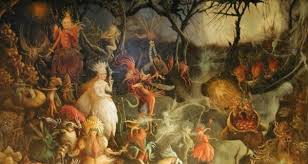
November 1st marked the end of summer and harvest and the beginning of the dark, cold winter, a time often associated with death. The Celts believed that on the night before the new year, the veil between the living and the dead was dropped and, on on the night of Oct. 31st, the dead would walk the earth once more.
They believed that these spirits would cause chaos and damage their crops. They also believed that the presence of spirits made it easier for Druids, or Celtic priests, to make predictions about the future. Druids would build huge sacred bonfires, where the people would gather to burn crops and animals as sacrifices to the Celtic gods. During this ritual, the Celts wore costumes, typically consisting of animal heads and skins, and went around telling fortunes.
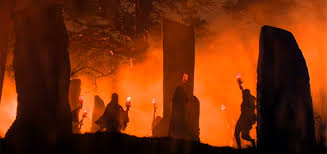
After this ritual, they would re-lit their hearth fires from the sacred bonfire, which would help protect them during the coming winter.
All Saints’ Day and All Souls’ Day
When the Roman Empire conquered the majority of Celtic territory, two festivals combined with Samhain. Feralia was a day when the Romans commemorated the passing of the dead and the second day was a day to honor Pomona, the Roman goddess of fruit and trees. Her symbol is the apple, which might explain where the game “bobbing” for apples came from.
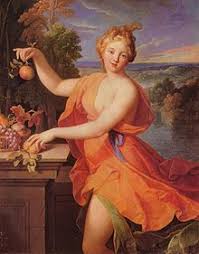
When the influence of Christianity spread into the Celtic lands, both religious traditions blended. The church made November 2nd All Souls’ Day to honor the dead.
All Souls’ Day was celebrated like Samhain, with big bonfires, parades and dressing up in costumes. However, the costumes worn on this day consisted of saints, angels and devils. Catholics would often pray for those in purgatory, waiting to go to heaven. Catholic Churches also had a Book of the Dead, where parishioners would write down the names of relatives to be remembered.
All Saints Day, which was celebrated on November 1st, was also called All-hallows or All-hallowmas, referring to the Eve of All Hallows, the night before people of the past were honored. Eventually, people began to call it All-Hallows Eve and, eventually, Halloween.
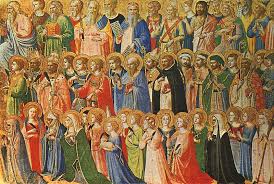
Halloween Comes to the New World
Halloween began to be celebrated on Oct. 31st, the evening before the two Christian holy days. In colonial New England, Halloween was extremely limited because of the rigid Protestant beliefs. However, Halloween was much more common in Maryland and the southern colonies.
European and American Indian beliefs and customs began to mesh, forming a very distinctly American Halloween. The first celebrations included “play parties,” which were public events held to celebrate the harvest. Neighbors would share their stories of the dead, tell each other’s fortunes, dance and sing. The telling of ghost stories and mischief-making also became part of the tradition. Americans even began to dress up in costumes, going house to house asking for food or money. This practice eventually became today’s “trick-or-treat.” Some young women even believed that on Halloween they could discover the name of their future husband by doing tricks with yarn, apple parings or mirrors.

A Very Victorian Halloween
In the late 1800’s, Halloween became more of a holiday, celebrating the community rather than ghosts, pranks and witchcraft. Victorians reveled in frightening tales and embraced the culture of death and mediums.
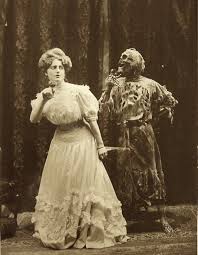
Victorian games, such as Pin the Tail on the Donkey, Blind Man’s Bluff (similar to Marco-Polo), Bobbing for Apples, foods of the season and festive costumes all became part of a traditional Victorian Halloween. Scavenger hunts, where boys and girls pair up and search in the dark, fortune telling and games to find your “true love” were extremely popular during house parties.
The Halloween pudding was a game where the host would bake a fruit cake with five objects hidden inside (a ring, a coin, a thimble, a button and a key). At 9:00 P.M., the oldest person would silently cut the cake and give each guest a piece. The first words spoken after the cake was cut would be prophetic for the year. The person getting the piece with the ring would be the first to get married, the person who received the coin would be wealthy, the button would meet their love, the key would go on a journey and the thimble would be an old maid or bachelor.
There was also a game where young women would go one by one into a dark room, which was claimed to be haunted, with a chest of drawers with boxes in them. They would then to go into the room in silence and collect a box from the drawer (filled with spooky party favors for all the guests) and try not to scream.
Lost Halloween Traditions
Many had to do with helping young women find their future husbands. In 18th century Ireland, a matchmaking cook would bury a ring in her mashed potatoes on Halloween night, hoping to bring true love to the person who found it.
In Scotland, fortune-tellers recommended that an eligible young woman name a hazelnut for each of her suitors and then toss the nuts into the fireplace. The nut that burned to ashes rather than popped or exploded, represented the girl’s future husband. However, some legends say that the nut that burned to ash symbolized a love that would not last.
Another tradition was that if a young woman ate a sugary concoction made out of walnuts, hazelnuts and nutmeg before bed on Halloween night, she would dream about her future husband.
Young women would also toss apple peels over their shoulders, hoping that the peels would fall on the floor in the shape of their future husbands’ initials. Some tried to learn about their futures by peering at egg yolks floating in a bowl of water. Others stood in front of mirrors in darkened rooms, holding candles and looking over their shoulders for their husbands’ faces.
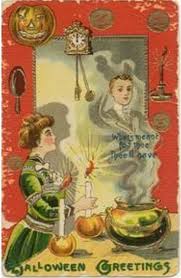
Then there were competitive rituals, where party goers would have to find a burr on a chestnut-hunt to see who would be the first to marry. Other parties had the first successful apple-bobber be the first to walk down the aisle.
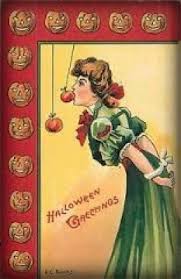
Halloween Today
By the middle of the nineteenth century, annual autumn festivities were becoming common. At the turn of the century, Halloween parties for both children and adults became extremely common. Parties focused on games, foods of the season and festive costumes. Halloween began to lose most of its superstitious overtones by the beginning of the twentieth century, as parents encouraged newspapers and community leaders to remove anything frightening out of Halloween celebrations.
Nevertheless, today, Halloween has morphed into a fun and frightening holiday, where kids dress up in whatever costume they want and go “trick-or-treating” with their friends and family. Halloween parties are still celebrated with the young and old, and houses are decorated every year to see who can be the best dressed house on the block. Thanks to our love of candy and decorations, Halloween is now the second largest commercial holiday after Christmas.
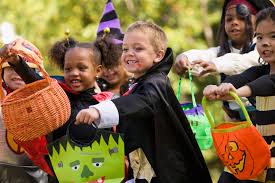
How did “trick-or-treat” start out?
Many believe that origins of this practice date back to the early All Souls’ Day parades in England. During the festivals, poor citizens would beg for food and families would give them pastries called “soul cakes” in return for their promise to pray for the family’s dead relatives. The church encouraged the distribution of soul cakes as a way to replace the pagan tradition of leaving food and wine for roaming spirits. Eventually, the practice became known as “going a-souling,” where children would visit houses and be given ale, food and money.
Where did dressing in costume come from?
Dressing in costume for Halloween can be dated back all the way to Samhain. The Celts believed that during Samhain, the dead would come back to haunt people. Many thought that if they left their homes they would encounter ghosts roaming the streets. So, to avoid being recognized by these ghosts, people would wear masks when they left their homes after dark. Perhaps they would then be mistaken for fellow spirits. Many would also place bowls of food outside of their homes to keep ghosts away. They hoped that by doing this, the ghosts would be appeased and would not enter their home.
7 Bizarre Gravesite Inventions
1. Safety Coffin
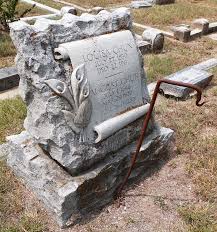
The safety coffin was a Victorian invention that came about because of people’s fear of being buried alive. In the late 19th century, books and newspapers were full of terrifying stories where individuals were accidentally buried alive. A solution to solve this problem was the safety coffin, or coffin alarm.
A bell, or another noise-making apparatus, would be outside of the coffin with a string situated inside the coffin to alert others that they were trapped. One of the more famous devices like this was created by Russian Count Michel de Karnice-Karnicki. It was a spring-loaded compartment atop the grave that would pop open like a jack in the box if there were any bodily movements below.
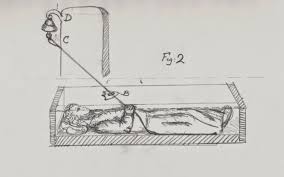
2. The Escape Coffin

These were built for those prematurely declared dead who didn’t have the patience to wait for someone else to come rescue them. Count Michel de Karnice-Karnicki’s contraption was a perfect invention for this. Other individuals, who were buried in a vault, put a wheel lock inside so that they could open the doors from the outside if they were locked.

3. The Waiting Mortuary
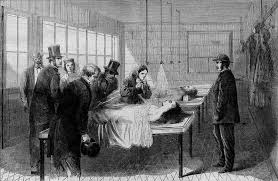
In 19th century Germany, corpses were laid out inside stately halls and monitored day and night for signs of revival. Sometimes, strings attached to bells would be tied around fingers and toes, a precursor to the coffin alarm.
4. Cast-Iron Coffins
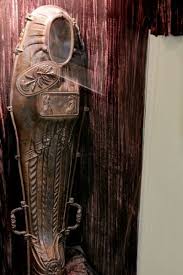
Inventor, Almond D. Fisk, patented a cast-iron coffin in 1848 for those who died overseas or a long ways away from home. These coffins would preserve bodies for extended periods of time.
5. Reusable Coffins
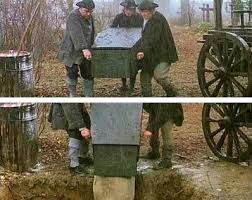
In 1784, Austrian Emperor Joseph II grew so concerned about Vienna’s extravagant funerals that he instituted the use of a reusable coffin. The wooden coffin contained a trap door in the bottom, where corpses, wrapped in sacks, would be discreetly dropped into their graves. The coffin could then be reused for other funerals. This caused a lot of outrage among the public.
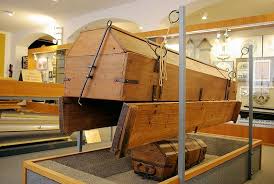
6. Mortsafes
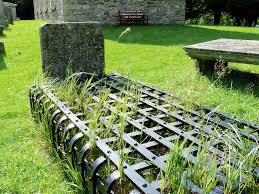
In the 19th century, grave robbers were on the prowl looking for corpses to sell to medical schools. The mortsafe, a heavy wrought-iron cage or stone, was designed to be placed over gravesites to prevent the theft of corpses. Often times, they have misinterpreted theses as cages meant to keep vampires from rising from their graves.
7. Coffin Torpedos
When corpse stealing increased after the Civil War, Americans found a more extreme way of theft-proofing their graves. These coffin torpedos would shoot lead balls when triggered by the opening of the coffin lid. Sometimes a landmine-like device sat atop the coffin and would detonate if the grave was disturbed.
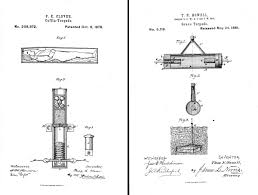

Firs happy Birthday beauty! Despite the change of lans it sounds like you had a good day! I also loved reading about the history! thank for sharing sweets! ❤
LikeLiked by 1 person
Thank you! 🧡 it turned out to be a good day even though I didn’t get to see my nephews, but they sent me a cute “Happy Birthday” video message lol I’m glad you enjoyed the content as well! 🎃🎃🎃
LikeLike
Don’t forget Halloween Eve or Hallow Eve as some of us call. I have my vacuum cleaned up and ready to fly the night away. I stopped using the broom eons ago couldn’t get the bones to bounce me up high to take office.
LikeLiked by 1 person
LOL! I love it! I laughed so hard 😆😆😆
LikeLike